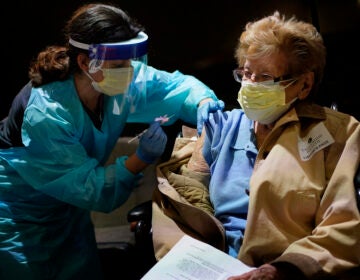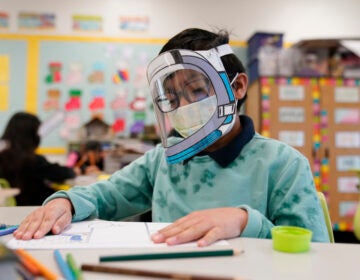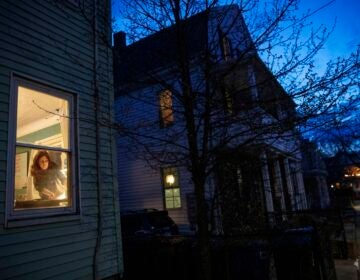Philly’s role as national COVID vaccine pilot site already over
The CDC invited Philly and 4 states to help develop U.S. strategy for distributing a vaccine. After a brief consult, a playbook was released nationwide.
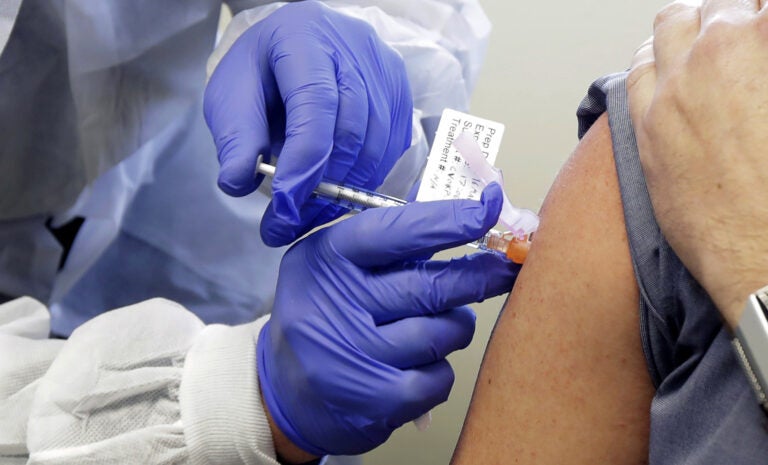
A patient receives a shot in a clinical trial for a potential coronavirus vaccine. (Ted S. Warren/AP)
Philadelphia is no longer part of a pilot program to help develop the nation’s coronavirus vaccine distribution plan.
It turns out that though the city was invited to participate by the Centers for Disease Control and Prevention, such a program never really existed — at least not in the way Philly officials had envisioned.
In early August, the CDC sent a letter to Philadelphia as well as the states of Minnesota, California, Florida and North Dakota, notifying them that they had been selected as one of five “pilot sites for joint planning missions” as part of Operation Warp Speed — the Trump administration’s effort to push SARS-Cov-2 vaccines through clinical trials and distribute them as quickly as possible.
City Department of Public Health officials were surprised by Philadelphia’s inclusion. They hadn’t applied to be a part of the pilot program, and only found out from the CDC’s letter, which was released to the public at the same time. Local officials say their best guess is that Philadelphia was selected because it already has robust vaccine database software, which will give it a bit of a head start in tracking who gets the vaccine and who doesn’t.
“Our thought was a lot of those very basic data questions are already answered in Philly,” said Health Department spokesperson James Garrow. “So we could focus our planning on what comes after that.”
In that August letter, the director of the National Center for Immunization and Respiratory Diseases, Dr. Nancy Messonnier, wrote that the selected jurisdictions “will serve as a pilot for supporting other jurisdictions and will provide valuable insight into state/local planning efforts.”
It instructed the jurisdictions to provide a plan detailing timelines, deliverables and metrics by Oct. 1.
Later in August, to prepare to write Philadelphia’s plan, the city Health Department staff and some state health officials had a meeting with CDC representatives spanning two days, to discuss potential challenges and roadblocks. The CDC had already met with the four states, and the agency’s representatives brought some of their ideas to the table. There was no real upshot or deliverables that came out of that meeting, according to Garrow — just an overall sense of what the challenges might be and how other jurisdictions were thinking about vaccine distribution.
From there, Philadelphia public health officials headed back to the drawing board to prepare their plan.
“CDC had never said what the template was or how they expected this document to be organized,” Garrow said. “It was really, ‘You’re the planning experts, you figure out the best way for how you’re considering doing vaccine distribution.’”
The department assembled a vaccine advisory board composed of health care professionals and experts who could advise on both medical and population-level concerns. By mid-September, Philadelphia was making progress on its plan, but still awaiting further guidance from the CDC in terms of what format their report should take.
Then, on Sept. 16, the CDC released an official playbook for how to design a vaccine distribution plan. But instead of being sent to the five pilot jurisdictions, it was sent to every single jurisdiction — cities, states, and territories — that the CDC funds. Now, everyone needed to submit a plan by Oct. 16.
It appeared Philadelphia’s pilot status had come and gone.
“The pilot project was essentially our meeting with CDC,” Garrow said. “And having some offline conversations with them to help develop what would go into this playbook. Essentially, that was it.”
CDC spokesperson Kristen Nordlund said it was the plan all along to consult the five jurisdictions and then release the playbook.
“It’s not really dropping one for another,” Nordlund said. “We just happened to reach out to the five first to hear what they were already thinking about, to help us when we sent out the handbook.”
Nordlund could not detail which elements of the 55-page playbook came out of the conversations with Philadelphia health officials.
It’s no real skin off Philadelphia’s back. Though it was a bit confusing. It was work the department was going to do anyway.
”We expected really up through the meeting with them we would be preparing a draft document for others to use,” Garrow said. “I can’t speak to CDC’s motivation for changing that — or why the details for that pilot project all along weren’t better communicated — but from our perspective, we don’t know that it would make all that much of a difference.”
Philadelphia is still working on its plan, now for Oct. 16. Garrow said he hopes to release a public version of it.
So, where does Philly’s vaccine distribution plan stand?
The actual plan for how to give out vaccines to Philadelphians depends on the type of vaccine, when it’s released, how many doses are allocated to Philadelphia, and who is chosen to receive it first. All that is still being worked on the federal level, while local jurisdictions make parallel plans to prepare for any number of scenarios.
The CDC is instructing all its jurisdictions to plan for a few potential options. The first involves a two-dose vaccine that must be stored at freezing cold temperatures, with 21 days between each dose. The second accounts for fewer storage requirements, but 28 days between each dose. The final option asks jurisdictions to plan for both vaccines to be released at the same time.
Though planning documents indicate the vaccine could come as early as the fourth quarter of 2020, new Food and Drug Administration regulations that require a two-month follow-up with patients enrolled in vaccine trials once they’ve received their final doses make it very unlikely a vaccine will be ready earlier than 2021.
The vaccine candidates in Phase 3 trials being developed by Pfizer and Moderna both require two doses. Johnson & Johnson’s vaccine, which just began its final stage of clinical trials, only requires one.
At its late August meeting in Philadelphia, the CDC told city health officials to prepare for three possible vaccine distribution channels, not mutually exclusive. The first is the typical method used each year for the flu vaccine. The federal government provides a vaccine allotment to the city, which is distributed to pediatricians and community health clinics. The second would be a direct allotment from the CDC for Philadelphia’s federal employees. The third would be directed toward commercial pharmacies, like CVS, Rite Aid and Walgreens.
How much vaccine Philadelphia can expect to receive through each of those channels depends on the prioritization scheme the federal government lands on.
The National Academy of Medicine released recommendations earlier this month that placed frontline health workers, public health workers and those essential to the vaccine supply chain at the front of the line. Those at the greatest risk of death and workers essential to core societal functioning, such as transportation, food supply and school employees, were also listed in the NAM’s first tier.
Anticipating challenges
Philadelphia officials learned from the CDC about some distribution plans the four other “pilot” sites were considering, but they were skeptical of those that revolved around drive-through vaccination sites at fire stations or stadiums. Since many people requiring vaccinations in Philadelphia may not have vehicle access, city officials want to make sure walk-up vaccinations are possible. That brings up the new challenge of making people wait outside in the cold for hours.The idea of using libraries has been tossed around.
In the event that the vaccine requires two shots, or that there is more than one vaccine available, the city will have to keep scrupulous records of who got which vaccine and when. That’s where Philadelphia’s advanced tracking software, PhilaVax, comes into play. Still, there’s the question of how to sync up with the databases in surrounding counties, and across state lines.
“Say someone lives in Montgomery County and comes into Philadelphia because they work at CHOP, and get their vaccine at CHOP,” Garrow said. “Are we losing a vaccine from our allotment for a Montgomery County resident? And do we communicate that information back to Montgomery County because it’s likely that their second dose they might get at a CVS around the corner?”
Garrow said interacting with jurisdictions outside Philadelphia is a challenge the city hasn’t yet broached, and that it’s relying on the CDC’s help.
Philadelphia is also counting on the federal government to shore up public trust in a vaccine. A recent Pew poll found just half of American adults would definitely get vaccinated for the coronavirus, down from 72% in May. Garrow said the Health Department is relying on a rigorous vetting process by federal agencies, so that it, in turn, can assure Philadelphians the vaccine is safe.
“I don’t know how we would deal with questions about the FDA’s process,” he said.vaccine
WHYY is your source for fact-based, in-depth journalism and information. As a nonprofit organization, we rely on financial support from readers like you. Please give today.


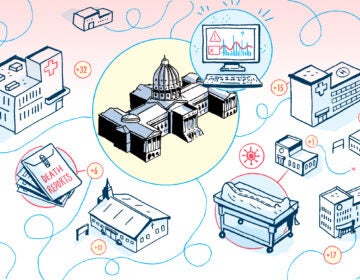
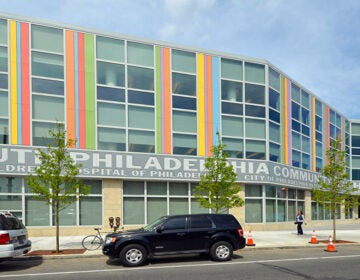

![CoronavirusPandemic_1024x512[1]](https://whyy.org/wp-content/uploads/2020/03/CoronavirusPandemic_1024x5121-300x150.jpg)
